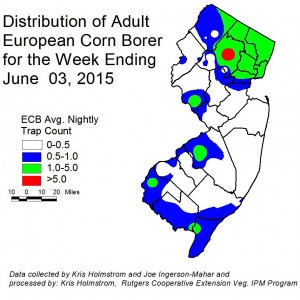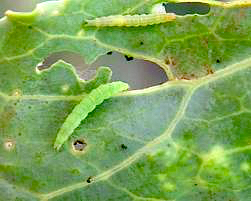Sweet Corn
 Cold temperatures and rain this week have prevented catches of European corn borer (ECB) from rising, and much of the activity represented in the map occurred over the weekend. Areas of highest activity include parts of Hunterdon, Morris and Burlington counties (see ECB map). Low level ECB infestations are present in early sweet corn plantings, and will become more significant with the return of drier weather.
Cold temperatures and rain this week have prevented catches of European corn borer (ECB) from rising, and much of the activity represented in the map occurred over the weekend. Areas of highest activity include parts of Hunterdon, Morris and Burlington counties (see ECB map). Low level ECB infestations are present in early sweet corn plantings, and will become more significant with the return of drier weather.
Be sure to begin monitoring plantings for ECB feeding while they are still in the whorl stage. Consider treating when the number of infested plants in a 50 plant sample exceeds 12%. Feeding in the whorl stage will appear as numerous small holes (called “shot-hole”) on leaves, with damage present on consecutively younger leaves. The earliest plantings now have tassels. As plants progress to pre-tassel and beyond, the actual larvae may be found in or on the emerging tassels. Any planting remaining at or above threshold as it proceeds to full tassel should be treated, as this is the last stage at which ECB larvae will be exposed and vulnerable to insecticidal sprays.
Often, early sweet corn plantings suffer from “split set”, in which germination does not occur in a uniform fashion. The result is a planting where all plants do not reach full tassel at the same time. This situation may require an extra tassel spray if there are several days difference in the time full tassel is reached on a significant number of the plants.
Insecticides that are acceptable in organic production include the spinosyn based material Entrust (IRAC-5) and Dipel (IRAC-11a). The 10G formulation of Dipel is particularly useful when granules can be dropped or broadcast such that they get into the whorls of corn plants. See the 2015 Commercial Vegetable Recommendations Guide for more insecticide choices.
For more information see:
| The highest nightly ECB catches for the previous week are as follows: | ||
| Denville 9 | Woodstown 2 | Long Valley 1 |
| Medford 3 | Belvidere 1 | Pedricktown 1 |
| Eldora 2 | Cedarville 1 | Pennington 1 |
| Green Creek 2 | Cinnaminson 1 | Sergeantsville 1 |
Several corn earworm moths (CEW) were captured in blacklights this past week. These individuals were found at Pedricktown and East Vineland. In addition, a limited number of CEW pheromone traps have been deployed throughout the southern counties. Several of these traps have captured CEW moths. As the earliest sweet corn plantings begin to silk, it is critical that growers monitor local CEW moth numbers. These early season moths target sweet corn exclusively and result in a level of damage that seems out of proportion to their numbers. Fortunately, this early “flight” tends to be very short lived. For the present time, any sweet corn plantings entering the silk stage should be treated to limit CEW injury as well as to prevent ear damage from ECB larvae that already inhabit the stalks.
| The highest nightly CEW pheromone trap catches for the previous week are as follows: | |
| East Vineland 2 | Beckett 1 |
| Woodstown 2 | Berlin 1 |
In the event that local sweet corn is silking or nearing silk stage, the following spray schedules are warranted.
Silking Spray Schedules*:
South – 6 days
Central – 6 days
Peppers
Young pepper plants are at risk of infestation from this first ECB generation. Be sure to scout fields regularly for the presence of ECB egg masses. If two or more egg masses are found in a 50 plant (two leaves/plant) sample, consider treating even if no fruit are present. In the absence of fruit, ECB larvae will bore into the central stem, topping the plant. This will result in the loss of crown fruit on infested plants. Generally, where blacklight trap catches average one or more ECB per night (blue and green areas on the ECB map) and fruit are greater than ½” in diameter, insecticides are warranted. See the 2015 Commercial Vegetable Production Recommendations for materials useful in controlling ECB.
Pepper Weevil Report
Several fields are being monitored, as well as, some produce handling facilities, but no weevils have been trapped in any location during the past week. The counts so far this year are well below those for the same time period in 2014. With no weevils caught in traps, no map will appear in this edition.
Cole Crops
A few diamondback moth (DBM) adults and larvae have begun to show up in cole crop plantings around the state, in addition to the increasing numbers of imported cabbage worms (ICW).
Better choices include:
[active ingredient – trade name (IRAC* code)]:
Spinosad/Spinetoram – Entrust/ Radiant (5) – Entrust also OMRI approved.
Chlorantraniliprole – Coragen (28)
Cyantraniliprole – Exirel (28)
Flubendiamide – Synapse (28)
- Cole Crops Scouting Methods, Thresholds, and Notes
- Cole Crops Insect Pests: Diamondback Moth Larvae
- 2015 NJ Commercial Vegetable Production Recommendations
Brown Marmorated Stink Bug (BMSB)
Several BMSB were captured in light traps this past week. Numbers are still very low overall. As adult captures increase to 5/night in parts of the state, maps will be produced to show where activity is highest. Information on scouting, crop injury and control will also be included.
| The highest nightly BMSB catches for the previous week are as follows: | |
| Cinnaminson 2 | Beckett 1 |
| Belvidere 1 | Downer 1 |
Joe Ingerson-Mahar and Kris Holmstrom would like to acknowledge the contributions of the 2015 IPM Program Field Technicians, without whom much of the information in this publication would be unavailable. This year’s technicians are as follows:
Tonia Broen, David Carpiniello, Sarah Laffend, Samantha Shen, and Ryan TirrellThanks gang!


